Transcend SSD320 & SSD720 (256GB) Review
by Kristian Vättö on January 25, 2013 11:31 AM ESTRandom Read/Write Speed
The four corners of SSD performance are as follows: random read, random write, sequential read and sequential write speed. Random accesses are generally small in size, while sequential accesses tend to be larger and thus we have the four Iometer tests we use in all of our reviews.
Our first test writes 4KB in a completely random pattern over an 8GB space of the drive to simulate the sort of random access that you'd see on an OS drive (even this is more stressful than a normal desktop user would see). I perform three concurrent IOs and run the test for 3 minutes. The results reported are in average MB/s over the entire time. We use both standard pseudo randomly generated data for each write as well as fully random data to show you both the maximum and minimum performance offered by SandForce based drives in these tests. The average performance of SF drives will likely be somewhere in between the two values for each drive you see in the graphs. For an understanding of why this matters, read our original SandForce article.

Random read performance is typical SandForce. The SSD320 comes in slightly slower, but the difference is a mere 3.9MB/s compared to SSD720.

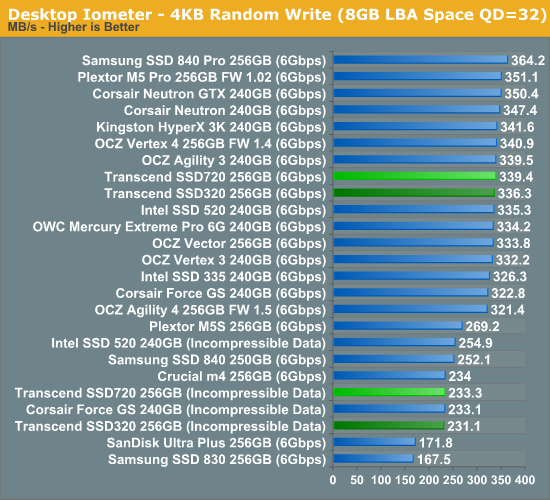
Same story with random write speed; the SSD720 performs hand in hand with Corsair's Force GS (except in QD32 test with compressible data, but Corsair had some issues with that particular aspect), though this is hardly a surprise given that they use identical NAND and the same stock firmware from SandForce. Due to SandForce's real-time compression, the slower NAND in SSD320 only shows up when the data is fed with incompressible data -- with compressible data the SF-2281 writes so little to the NAND that something else becomes a bottleneck even with asynchronous NAND.
Sequential Read/Write Speed
To measure sequential performance I ran a 1 minute long 128KB sequential test over the entire span of the drive at a queue depth of 1. The results reported are in average MB/s over the entire test length.
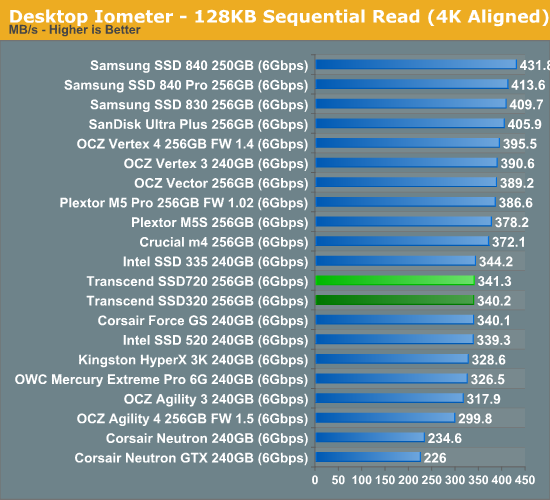
Moving to sequential tests, the SSD720 offers marginally faster write performance than the SSD720.
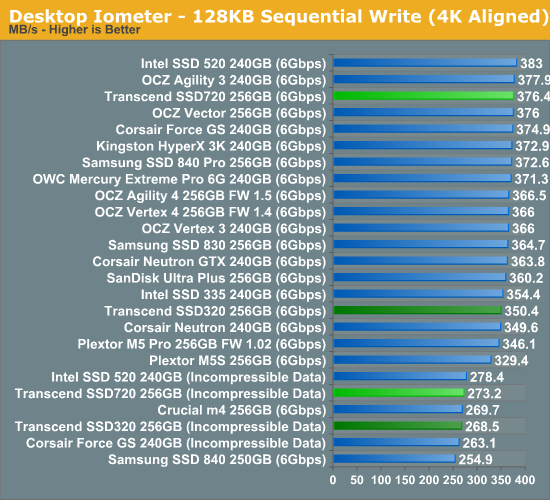
AS-SSD Incompressible Sequential Performance
The AS-SSD sequential benchmark uses incompressible data for all of its transfers. The result is a pretty big reduction in sequential write speed on SandForce based controllers.
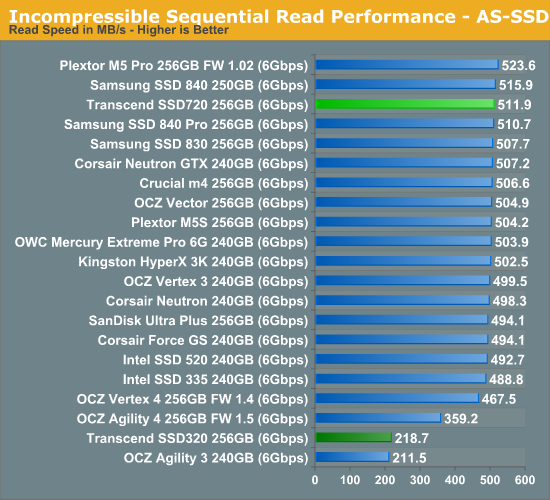
Asynchronous NAND has an enormous impact on incompressible sequential read speed as you can see above. The SSD320 and OCZ's Agility 3, another async NAND based SandForce SSD, perform poorly in this test. It's not a bug or error in our testing as I checked the product specs for the SSD320 and they specified that the maximum read speed for AS-SSD is 220MB/s. When using slower NAND, the performance will be handicapped in scenarios where the NAND is the bottleneck. In this case, the controller and SATA 6Gbps bus are capable of faster throughput but the NAND can't keep up. I believe SandForce's compression adds some overhead as well because the data has to be decompressed -- the Agility 4 with no compression is faster even though it's using async NAND as well.
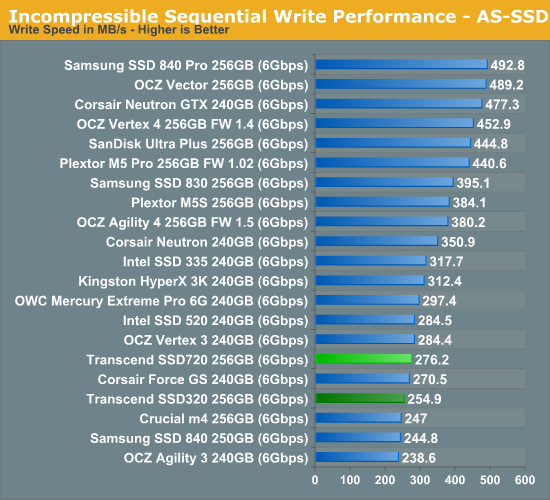










34 Comments
View All Comments
Beenthere - Saturday, January 26, 2013 - link
Many enthusiasts base their PC hardware purchases strictly on synthetic benches, which is laughable when many folks have no clue the benches are not necessarily accurate or representative of the actual performance of the hardware. It doesn't matter if it's an SSD, RAM, mobos, HDDs or other products, the benches can be very misleading.I defy anyone to accurately tell the difference in system performance in a blind test... between any popular SATA II and SATA III SSD, regardless of cost, when comparing the same size drives. The same goes for DRAM, I defy anyone to tell the difference in a blind test... between RAM running @ 1333 MHz. and @ 2000 MHz. in any Intel or AMD powered desktop PC. It's simply impossible to do though the uninformed will argue to their dying breathe but not actually run blind tests to prove it to themselves.
That being said, if you're willing to take a chance on lost data, regular firmware update requirements to fix issues, RMA's, etc. with an SSD, picking an SSD for most folks should be based on your needs, the SSD's reliability, compatibility, manufacturer reputation for warranty/service and price. FYI - Longer product warranties do not necessarily mean better quality drives be they SSDs or HDDs. You can completely forget benchmarks as they are for new, clean drives and mean nothing in the real world nor is the difference in system performance even discernible.
If you want a real good laugh - go to the major SSD maker websites and find the complete SSD warranty and read it carefully. Find out what your real cost/inconvenience/losses are if the SSD has a defect/fails. It ain't pretty... in many cases.
jason_mcallister - Sunday, January 27, 2013 - link
I really like your post and completely agree with your statements. I find it curious that more folks don't also see things this way. I was gullible in paying a premium for my DDR3-2400. If I had done some research before the purchase I would have realized that it wasn't a performance increase that I would have ever noticed. People, in which I include myself, are always looking at the benchmarks (metric tests) and kind of shut off the critical thinking process. Thankfully, I'm a little wiser these days and have a better process for making purchase decisions.alkhrt - Sunday, January 27, 2013 - link
It's great to see the price /GB close to $1., but 1TB worth of SSD ~$1000, while 1TB HDD ~$70. I can't believe with no moving parts etc. that SSD's are 14x more expensive to produce. Still feel like I'm getting the shaft buying one.Scour - Saturday, February 16, 2013 - link
The funny thing: The 320 was one of the cheapest 256GB-SSD at the arrival, only some old OCZ (240GB Vertex/Agilty 2, 256GB Petrol) were cheaper.Now it´s more expensive than M5S, M4 Hyper X 3k, Intel 335. OK, most SF-SSDs only offers 240GB, but for example the 335 ist about 14€ cheaper.
So I see no reason to buy a Transcend 320, my first choice in this class is the Plextor